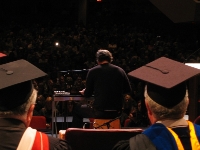In an entry before on the Academical Village I speculated about hybrid campuses that have both virtue and physique (virtual and physical extension). Now I want to put this another way: How can the intersection of art and technology be expressed in a campus or building? I am interested in examples of buildings designed to house art and technology programs, research and development. Are there ways the design of space can facilitate the desired interactions and exhibit the intersection of art and digital technology? What would Jefferson design?
Two campuses come to mind as example, IT University of Copenhagen – The ÿrestad Building is being purpose built to house a new university around IT that includes Aarseth’s Game Studies unit. If you look at the animations you can see features like the use of glass, large atrium, and projections that suggest an architectural implementation of the values of the new university (which are direction-finding, forthcoming, and accountable.) Openness and transparency is probably a better word than “forthcoming” – I suspect something was lost in translation.
The second, and older, example is the MIT Media Lab: Wiesner Building that was designed by I.M. Pei in 1985. MIT is now added a new building next to it, see the Plan #54. Just as interesting is the Gehry Stata Center for CSAIL (Computer Science and Artificial Intelligence Lab).
Continue reading ITU of Copenhagen: Building
